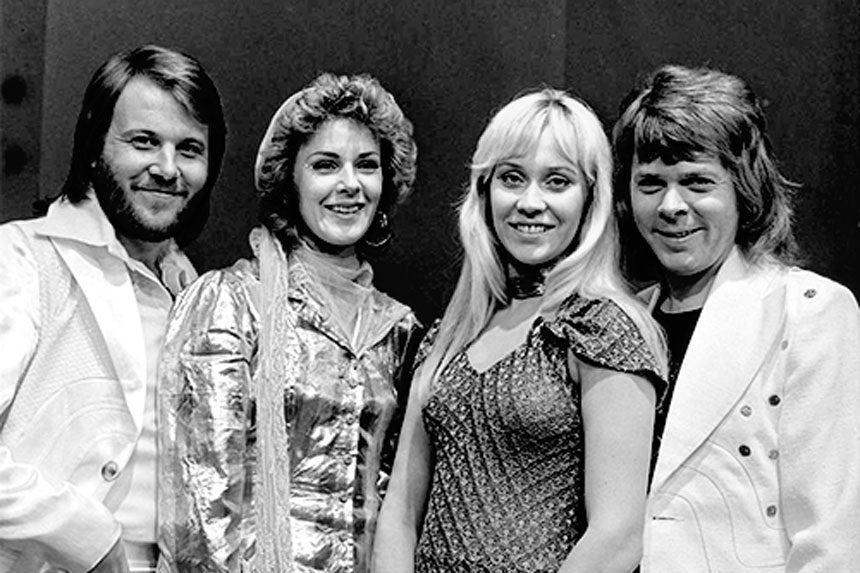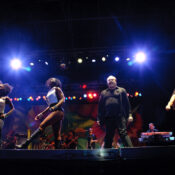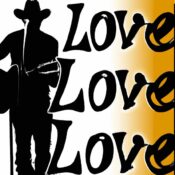One of the best-loved music groups of all time, ABBA has also staked their claim as one of the best-selling acts in history. Members of the Rock and Roll Hall of Fame, with worldwide record sales estimated to be in the hundreds of millions, the quartet dominated the pop scene for most the 1970s and into the ’80s before the two married couples each divorced and went their separate musical ways. The continued popularity of their music and their increasing influence kept them in the limelight until a totally improbable reunion after a 40-year hiatus returned them to the top of the charts. Though their history is fairly intricate and spans decades, here are ten major ABBA moments.
1. Making a Name
Benny Andersson and Björn Ulvaeus had each established themselves with popular bands in their native Sweden by the mid-1960s. Keyboard player Benny was in Hep Stars, and guitarist/vocalist Björn belonged to The Hootenanny Singers. Benny had already written a number of hits for his band before they decided to write together in 1966. The Hootenanny Singers’ manger Stig Anderson realized the possibilities that the team presented and pushed them to keep going. When one of their compositions became a contender to be Sweden’s Eurovision entry in 1969, Benny met another performer, vocalist Anni-Frid Lyngstad. They quickly became a couple, and Benny began producing some of her material. In 1969, Björn had met singer Agnetha Fältskog; she’d already had a #1 hit at the age of 18. The two would marry by 1971. Soon, all four were working together, either writing and producing on Anni-Frid or Agnetha’s solo albums or assembling material as a group. In 1972, the quartet, billed under the unwiedly name of Björn & Benny, Agnetha & Anni-Frid, released the song “People Need Love.”
2. Debut Album
“Ring Ring” (Uploaded to YouTube by ABBA)
50 years ago this week, they released their debut album, Ring Ring, again as Björn & Benny, Agnetha & Anni-Frid. However, Stig Anderson knew that the name was a non-starter in many markets. Combining the first letters of each performer’s name, he came up with the moniker they would always be known by: ABBA. Ring Ring was a hit all over Europe, setting them up for future success. In fact, it was only after the song hit that the four knew that they could, forgive me, take a chance on continuing as a group.
3. Eurovision
“Waterloo” (Uploaded to YouTube by ABBA)
After some previous disappointing swings at trying to represent Sweden in the Eurovision song contest, the group took something new to Melodifestivalen 1974, the Swedish preliminary event for Eurovision selection. ABBA submitted their glam rock-inspired tune that compared a broken love affair to a famous battle: “Waterloo.” At the time, a number of Eurovision entrants were somewhat folky (even hokey), but ABBA leaned into a pop-rock direction and made the fairly bold decision (for the time) to sing in English. The insanely catchy tune carried them to Eurovision victory on April 6, 1974. Now instantly recognizable in Europe and with a batch of fresh material, they had a significant opportunity to make real dent in the elusive U.S. market. “Waterloo” went #6 in the States, followed by the #27 “Honey Honey.” Napoleon may have failed at Waterloo, but for ABBA, it was the successful start of their own Swedish invasion.
4. 1975
“SOS” (Uploaded to YouTube by ABBA)
ABBA’s self-titled 1975 album established them as major stars in the U.S., Japan, and Australia in addition to Europe. It produced three Top 40 hits in the States: “I Do, I Do, I Do, I Do, I Do,” “SOS,” and “Mamma Mia.” The record really epitomized the ABBA sound, which is many things without being just one thing. It certainly included rock elements (consider the guitar on “Mamma Mia” or the “When you’re gone/How do I even try to go on” passage of “SOS”), but was also informed by dance music (notably disco), hook-driven pop elements, Benny’s sophisticated keyboards, folk aspects, and the absolutely killer harmonies of Anni-Frid and Agnetha. It was, for lack of a better descriptor, ABBA. In addition to touring, ABBA was able to appear around the world via music videos, over 30 of which were directed by Swedish filmmaker Lars Sven “Lasse” Hallström, who would go on to film success with movies like What’s Eating Gilbert Grape? and The Cider House Rules.
5. Dancing Queen
“Dancing Queen” (Uploaded to YouTube by ABBA)
For the next two years, ABBA would continue to crank out hits like “Fernando,” “Knowing Me, Knowing You,” and “Money, Money, Money.” But nothing could prepare anyone for what was arguably the ABBA song: “Dancing Queen.” Biographies of the group (notably 2005’s ABBA: The Complete Guide to Their Music by Carl Magnus Palm and 1995’s ABBA: The Name of the Game by Andrew Oldham, Tony Cadler, and Colin Irwin) related the emotional impact of hearing Benny’s disco-inflected musical backing track for the first time. Anni-Frid admitted to crying upon first listen, and Agnetha would say “It’s often difficult to know what will be a hit. The exception was ‘Dancing Queen.’ We all knew it was going to be massive.”
The band debuted the song in performance at perhaps the most appropriate venue possible. King Carl XVI Gustaf of Sweden was set to marry Silvia Sommerlath on June 19, 1976. At a televised gala held the night before at the Royal Swedish Opera, ABBA played “Dancing Queen” live for the first time. The reaction was seismic. “Dancing Queen” hit #1 in over 20 countries, including the Soviet Union (let’s repeat: #1 in Cold War 1970s Soviet Union). It would be the group’s only U.S. #1 and has been certified with sales of more than four million copies worldwide.
“Dancing Queen” is easily ABBA’s signature song. It’s exhibited an incredible cultural staying power and continues to draw praise. In their appraisal of the greatest songs of the 1970s, famously prickly music site Pitchfork heaped high praise on the tune, with Cameron Cook writing: “[the song] bottles the out-of-body euphoria that accompanies dancing for dancing’s sake, with no agenda or motive other than pure joy.” Popular and impactful, “Dancing Queen” spurred the creation of other great songs of that decade; Blondie’s Chris Stein admitted that the song was a huge influence on “Dreaming.”
6. Take A Chance on Me
“Take A Chance On Me” (Uploaded to YouTube by ABBA)
After “Dancing Queen,” ABBA’s biggest hit in America was 1978’s “Take a Chance on Me.” Proving that inspiration can come from anywhere, Björn has recounted that the song’s rhythm came from sounds he repeated to pace himself while taking runs. He and Benny turned that repetitive consonant sound into the chant-like invocation of “take-a-chance/take-a-take-a-chance-chance” that began the foundation of the track. The group harmonized the chorus while the ladies traded the verse parts. The bouncy, upbeat tune hit #3 in the U.S. It would be their penultimate Top Ten single in the States; “The Winner Takes It All” would hit #8 in 1980.
Though ABBA remained massively popular worldwide, internal tensions took a toll. Björn and Agnetha divorced in 1979, and Benny and Anni-Frid split in 1981. The band went on an official hiatus after a performance near the end of 1982. That hiatus would last almost 40 years. Benny and Björn continued to work together, co-writing the musical Chess with Tim Rice (which produced worldwide hit song “One Night in Bangkok”) and other projects. Both Agnetha and Anni-Frid had productive solo careers. But for all intents and purposes, ABBA was gone.
7. ’90s Revival
Erasure’s cover of “Take A Chance on Me” (Uploaded to YouTube by Erasureinfo)
Or was it? While the ’80s in America saw ABBA turn up as the subject of jokes in TV shows like The Facts of Life (the other girls couldn’t fathom Tootie’s fandom), the next decade would be much kinder. The 1990s saw a reinvigorated interest in the group, spurred by a variety of projects. English synth-pop duo Erasure released a four-song cover EP, Abba-esque, which was a huge hit in 1992. That same year, Benny and Björn performed “Dancing Queen” on stage with U2 at the Irish band’s Stockholm concert. That September, a new compilation, ABBA Gold: Greatest Hits, landed with a bang. “Dancing Queen” returned to the charts in a number of countries, and the collection would go on to sell 30 million copies around the world. Even parody tribute band Björn Again became a big success. Diverse contemporary artists ranging from Kurt Cobain of Nirvana to Dionne Warwick professed their admiration for the group’s music.
8. Mamma Mia and More
“Mamma Mia” (Uploaded to YouTube by ABBA)
The resurgence in interest was further propelled by the prominent deployment of ABBA songs in various films. In 1994, two Australian films, Muriel’s Wedding and The Adventures of Priscilla, Queen of the Desert, increased their profile at the box office dramatically with the inclusion of ABBA tunes. However, a further, massive boost would be provided by the 1999 stage musical, Mamma Mia!. With a book by the Catherine Johnson, the musical incorporated approximately 23 ABBA songs as written by Benny and Björn; it was a smash and led to a 2008 film adaptation starring Meryl Streep (as well as a film sequel).
9. Rock and Roll Hall of Fame 2010
“Does Your Mother Know” (Uploaded to YouTube by ABBA)
ABBA was inducted into the Rock and Roll Hall of Fame with the 2010 class; their welcome speech was presented by Barry and Robin Gibb of The Bee Gees. Anni-Frid and Benny attended to accept (Agnetha was, at the time, eschewing air travel, and Björn cited family obligations). ABBA had proven to be impervious to the “disco” stigma that plagued other acts (like the Brothers Gibb, which is why they were appropriate inductors), and the revived interest in the group and widespread admiration for Benny and Björn’s songwriting had made their eventual inclusion a forgone conclusion. Nevertheless, the four famously refuted any possibility that they’d ever reform.
10. The Return
ABBA Voyage trailer (Uploaded to YouTube by ABBA Voyage)
Never say never. In January of 2016, the four members of ABBA appeared in public together for the first time in decades for the opening of Mamma Mia!: The Party, a themed restaurant in Stockholm near the ABBA Museum. At a private party celebrating Benny and Björn’s first meeting 50 years prior that June, Anni-Frid and Agnetha sang the ABBA tune “The Way That Old Friends Do” in Benny’s honor; when Benny and Björn joined them onstage for the end of the song, it was international news. By October, British manager Simon Fuller announced that ABBA would be reassembling to record new music for what would eventually become ABBA Voyage. ABBA Voyage was a virtual residency with “ABBAtars” (digitally created avatars of the group’s younger selves, created from motion capture of the group by Industrial Light and Magic) performing in a specially designed theater. While the project saw COVID-19-related delays, the new material expanded into Voyage, an entirely new ten-song album.
“Don’t Shut Me Down (Lyric Video)” (Uploaded to YouTube by ABBA)
As you might expect, the new album was a raging success upon its November 2021 release, with “Don’t Shut Me Down” giving the group their first Swedish #1 song since 1978. ABBA Voyage sold over a million tickets for the London theater show. In March of 2023, it was announced that Voyage would hit the road, taking virtual ABBA virtually everywhere. Full details have yet to be revealed, but it’s fairly certain that the show will be warmly received by fans around the world. With their ongoing success, their seemingly timeless songs, and an obvious appetite for the group’s work, it doesn’t appear anyone or anything will be shutting ABBA down anytime soon.
Become a Saturday Evening Post member and enjoy unlimited access. Subscribe now




Comments
Grace, thou art a lady of excellent taste worthy of your first name. I appreciate thy comments, and sympathy on my musical screw-up of yore at the Music Center. I love the idea of our attending that June 1976 event together all decked out; if only there was a time machine. In lieu of that, a big hug and my best wishes. Thank you.
I enjoyed the article too, and appreciate knowing ABBA put out a new album fairly recently and their new virtual show. Bob, I agree with you on Mamma Mia. I saw the movie and didn’t like it either, so don’t be hard on yourself. It’s tough though when you’ve spent a lot on something, trust me. I loved seeing the ’76 Dancing Queen performance here, and the 18th century styles. You and I dressed up attending together would have been a total blast!
Great article on the 70’s Fab Four, including their back story with wonderful links on that and their music. A lot I didn’t know. ‘Don’t Shut Me Down’ is a tremendous new (late ’21) song, and I’m going to get the CD. I definitely want to see ‘ABBA Voyage’ when it comes to (hopefully) The Music Center later this year, or next.
The use of special effects in the best possible elevated, high end sense of the word. (The meaning of the term otherwise meaningless due to endless brain-dead comic book/action/carnage/yada yada films, unfortunately). ‘Voyage’ is a spellbinding, musical odyssey not to be missed.
Incredible 1976 video of ABBA performing ‘Dancing Queen’ at the Royal Swedish Opera. I would have LOVED being there, dressed-out 18th century as well myself, of course. No question about it. It would have been great here too, for the Bicentennial, with Gerald and Betty Ford in attendance (say) at the Kennedy Center? YES, for sure!!
ABBA was a Swedish delight on the 70’s musical smorgasbord. I got my mom on board as a fan too. Unfortunately it blew up in my face in 2003 when I bought tickets to see the stage play of ‘Mamma Mia’ at the Music Center for her birthday. The story was terrible and stupid; a bad disjointed mess. I was very embarrassed and sorry during it and afterwards. Didn’t do your homework obviously, did ya Boberino?! It was an expensive mistake too. Yaaay.
Mamma Mia was also a big key factor. First late summer 1976 there was only a video. In Australia the video went sky rock and all where asking for the single. So they released “Mamma Mia”, what unbelievably was not planned, and it was the start for Abbamania in Australia and later around the world.
And there is another key factor. The four supplemented each other on a magical way. Benny made great music, Björn did magical word, Agnetha has much influence on the finishing touch of the songs and Frida made the fashion. There where four geniuses in their area and created a perfect ensemble.
Karin, you are of course correct, and I amended that sentence. Thank you for reading!
Thank you for the article. Correction to the June 2016 duet of Agnetha and Frida at Berns: the event was to celebrate the 50th anniversary of Benny and Björn meeting. Both B&B had been in the music industry for several years before then.